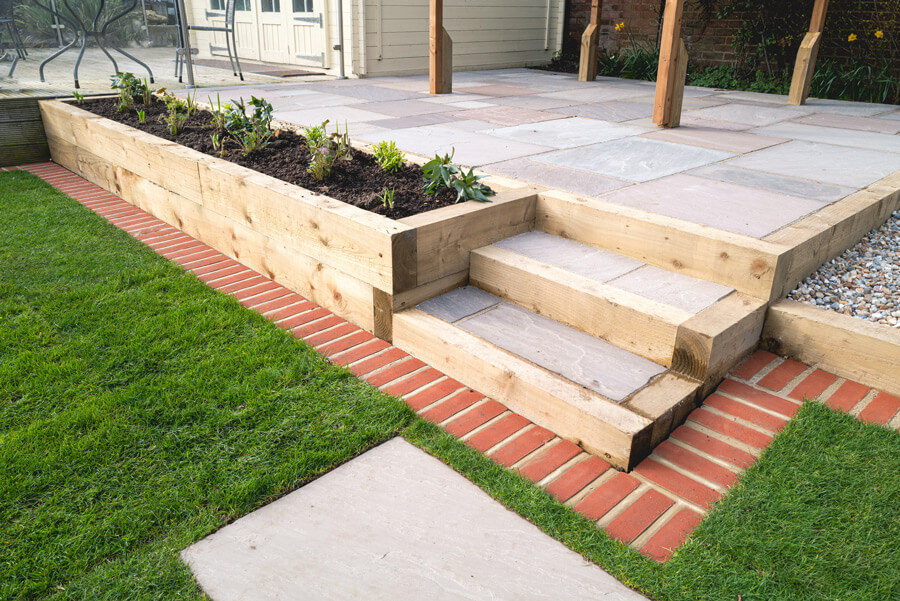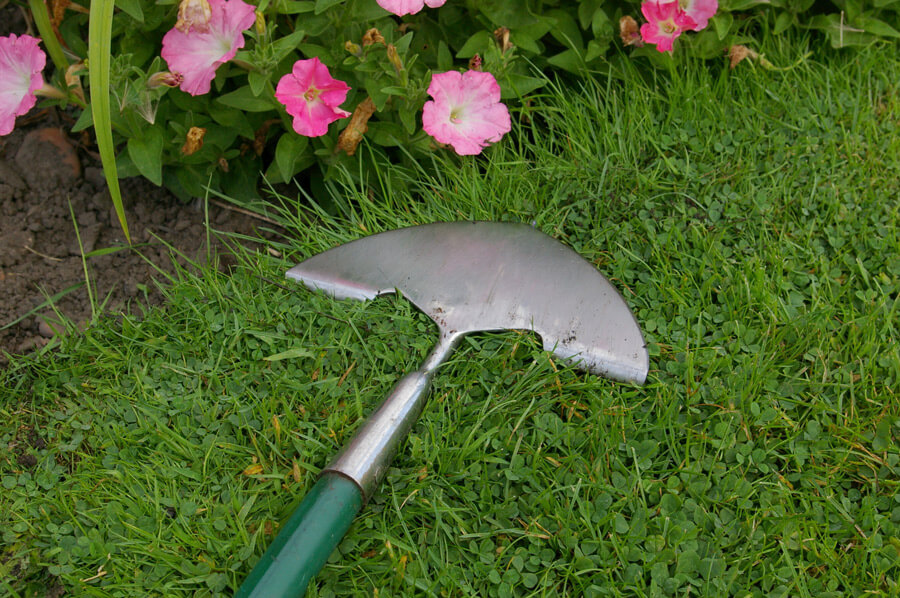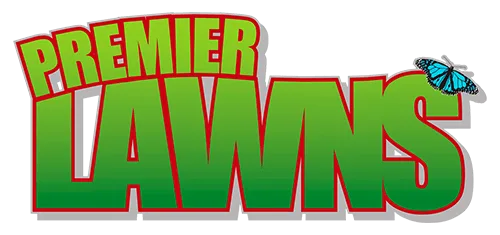Even the healthiest lawns look awful if the edges are not neat and tidy. In this article I’m talking about caring for and repairing your lawn edges
Funny how such a small detail can really trick the eye. I’ve seen lawns that are full of moss but still look great from a distance, simply because the edges are well defined, sharp and beautifully manicured. So how can you achieve this look with your own lawn?
Mower friendly edging
In an ideal world, every lawn would have mower friendly edging. What do I mean by that? Well some sort of hard surface that sits just a little lower than the lawn so that you can trim it by running over it with the mower.
Lawn edging saves hours of work (and backache) trying to re-shape the lawn and trimming off those little whiskery bits that blur the edges.
Steel lawn edging is very fashionable at the moment, but you could also use timber, brick or paving.

There’s a lot going on in the picture above. First of all, the patio is raised slightly. Now, no mower can cut right up to a raised edge like that. So to avoid weekly strimming or trimming, the landscaper has put a pretty brick edging all the way around the patio.
Now look at the stepping stone in the foreground. A brick edging here would be overkill but the stone is positioned perfectly so that it’s level with the lawn. It won’t trip anyone up but neither will it catch on the mower blade.
Natural lawn edges
There’s something quite appealing about natural lawn edges. Yes, they do need a little more intensive care than a solid edge but actually, if you keep on top of the work, it’s not so bad. And if you get an edging tool that’s the right size for you (so no stooping to use it), edge trimming can be quite relaxing and VERY satisfying.
Caring for natural lawn edges
To keep natural lawn edges looking sharp, they need a trim every time you mow your lawn. Or at the very least every second or third time.
AVOID mowing right up to the edge. There’s a real risk that the mower wheels will slip over the edge and you’ll scalp the grass. Worse, there’s a potential for a rotary mower to chew up the thatch and soil layers on the boundary leaving a raggedy edge. Yuk
Let’s start with some preventative action
When I’m mowing a lawn with a natural edge I make a point of whizzing around the edge with the strimmer first. It takes a bit of practice to get this first round at a similar height to the mown lawn – but you’ll soon get the hang of it.
My next move is to carefully mow three or four mower-widths around the lawn. This gives me plenty of room to turn the mower around when I start walking up and down. In other words, less risk of damaging those edges.
Regular edge trimming
Nipping around the edge of the lawn to take off the whiskery edges really doesn’t take long. I have a couple of tools in my van that make the work a pleasure.
The first is my long handled edgers. Choose a pair with telescopic handles so that you can adjust them to suit you. If you find yourself bent over or stopping the edge the lawn you’ll have a sore back – and you’ll not enjoy the work.
Be very sure to keep those blades sharp. Just like your mower – dull blades will leave ragged edges on the grass blades, the wounds will heal slower and the plants will be more susceptible to disease.
Mechanical lawn edger
This Milwaukee lawn edging attachment is a blessing. I love cordless tools, they’re kinder to the environment, I don’t need to store petrol for them and they tend to be light weight and easy to handle.
This does exactly what the hand shears will do – but quicker and much neater. Plus, it is compatible with my hedge trimmer.
For a lawn that sits against steps, a patio or a fence, try a cordless trimmer. It does mean getting on your knees but you’ll get a fantastic finish
Repairing lawn edges
From time to time, you might need to sharpen up or repair your lawn edges. The simplest method is to use a nice, sharp half-moon cutter and work your way around the lawn. To get a straight line, use a piece of cord strung between two pegs to mark where you need to cut. For a curvy lawn, lay a hosepipe on the lawn in the shape you want to see.

The half-moon method is OK for longer stretches of lawn that just need tidying up. But you may have just a small section of lawn edge that is very damaged or misshapen. Here’s an old gardener’s tip for fixing it.
How to repair damaged lawn edges
1. First, use a sharp knife or a half-moon cutter to cut out the section of the lawn that is affected. Leave at least 15 cm either side of the damaged edging and cut 30 -50 cm back into the lawn. Be very careful to get the edges straight and the width of the section very even all the way along.
2. Now use a sharp spade to lift the section you’ve cut out. Try to have at least 25mm (1 inch) of soil on the back of it. Bingo! You’ve made yourself a little piece of turf.
3. Turn your piece of turf around by 180 degrees. Fit it back into the space you’ve just made. The edge that is straight and narrow, becomes a new section of lawn edging.
4. The old, uneven edge will look like a scar on your lawn. Mix some grass seed with some sterilised topsoil together and use them to fill the scar….just like in my lawn repair video. (see below)
Keep the whole area well-watered until your turf has rooted into the soil and the grass seed is growing strongly. Depending on the time of year, it will only be a matter of weeks before the repair will disappear.
Of course you could use fresh turf from the garden centre to repair your lawn edges. But unless the turf grower has used exactly the same seed mix and soil type as your lawn – you will see the difference for a good few months. Better to use your own turf and have an exact match. The other advantage of course is that there’s no cost and no dirty turfs in the boot of your car.
For more lawn care hints and tips, subscribe to my YouTube channel for regular lawn care videos covering routine lawn care, lawn renovations, and every kind of lawn problem you can think of.
Click here to subscribe to Premier Lawns on YouTube
You might also like these articles
How to mow stripes into your lawn


